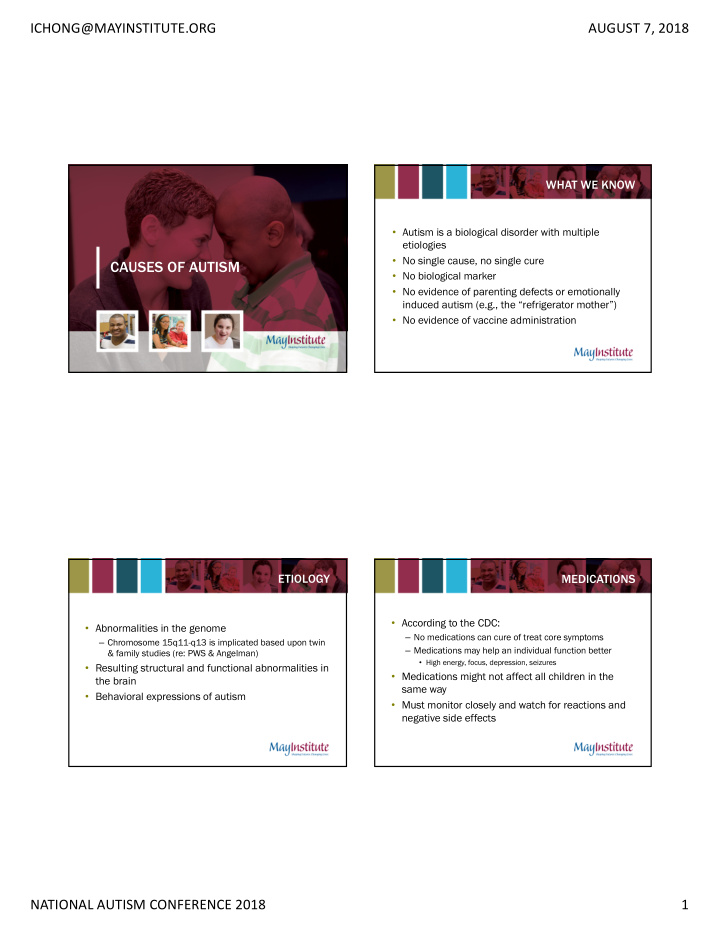



ICHONG@MAYINSTITUTE.ORG AUGUST 7, 2018 WHAT WE KNOW • Autism is a biological disorder with multiple etiologies • No single cause, no single cure CAUSES OF AUTISM • No biological marker • No evidence of parenting defects or emotionally induced autism (e.g., the “refrigerator mother”) • No evidence of vaccine administration ETIOLOGY MEDICATIONS • According to the CDC: • Abnormalities in the genome – No medications can cure of treat core symptoms – Chromosome 15q11-q13 is implicated based upon twin – Medications may help an individual function better & family studies (re: PWS & Angelman) • High energy, focus, depression, seizures • Resulting structural and functional abnormalities in • Medications might not affect all children in the the brain same way • Behavioral expressions of autism • Must monitor closely and watch for reactions and negative side effects NATIONAL AUTISM CONFERENCE 2018 1
ICHONG@MAYINSTITUTE.ORG AUGUST 7, 2018 EFFECTIVE TREATMENT LOVAAS (1987) • 47% of children became indistinguishable from • Government Mandate to provide appropriate their peers educational services in USA 1975 • 19 children with diagnosis of autism • Emergence of effective methods of treatment • 40 hours/week of structured ABA for 2 - 6 years – Lovaas (1987): landmark study • 42% moved from a self-contained or autism room • Availability of financial, clinical and educational to a language-delayed room resources and expertise • 10% saw little improvement • 89% saw substantial improvement STUDENT PLACEMENTS Homebound/ Private Residential, Public Day, Hospital, Day, 0.50% 8% 0.30% 0.70% Self Full Inclusion, 39.50% Contained, 33.30% Partial Inclusion, 18.10% 33 U.S. Department of Education, National Center for Education Statistics (2014) NATIONAL AUTISM CONFERENCE 2018 2
ICHONG@MAYINSTITUTE.ORG AUGUST 7, 2018 MEDICAL DIAGNOSIS MEDICAL VS EDUCATIONAL • To address treatment, we need to understand a A medical diagnosis of ASD is made by a doctor or medical diagnosis vs. an educational need. other specially trained clinician by using symptom criteria set in the Diagnostic and Statistical Manual of • Services and options within each system are varied Mental Disorders (DSM) or the International and target different skills. Classification of Diseases (ICD). DIFFERENCES SIMILARITIES • Medically Necessary: Educational : • Developed after the initial assessment that Guided by an Individualized Education Program identifies the needs to be addressed. • Guided by treatment plan overseen by a BCBA Targets academic goals • Includes the objectives, interventions, and time • Targets diagnostic criteria Delivered by a special educator or aide frame for accomplishment and evaluation • Delivered by a QHCP NATIONAL AUTISM CONFERENCE 2018 3
ICHONG@MAYINSTITUTE.ORG AUGUST 7, 2018 CONSIDERATIONS EDUCATION • MORE than a diagnosis. Require that a student is • Intellectual Disabilities in need of specialized services. • Intellectual Developmental disorder • Services are determined by an Individualized • Communication Disorders Education Program (IEP) team. • Autism Spectrum Disorders • May include some of the interventions used in the • Attention Deficit/Hyperactivity Disorder medical system (e.g., behavior or speech therapy), as well as other supports and specialized • Specific Learning Disorder educational placements as determined by the IEP • Motor Disorders team. CAUTION TAKE AWAY • Students with ASD are students first • One test should not be used independently for diagnosis; should be used as part of a • Evidence based practices are starting points comprehensive evaluation. • Support participation through environmental arrangement and teaching • Multiple assessment measures (e.g., ADOS and • Varied levels of support on a range of skills, across ADI, SRS, SCQ, ASDS, CARS, BASC, Vineland, etc) different activities, through life are highly dependent on expertise of tester and • Lack of progress or growth is instructional failure concerns reported NATIONAL AUTISM CONFERENCE 2018 4
ICHONG@MAYINSTITUTE.ORG AUGUST 7, 2018 DISCUSSION • What is your profession, job, job setting and educational level? • What are your responsibilities related to children with autism? • What are the strengths of your program? • What challenges do you have in your work with children? • What challenges do you face in your classroom ? • What do you hope to learn today? NATIONAL AUTISM CONFERENCE 2018 5
Recommend
More recommend